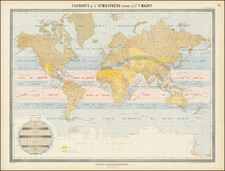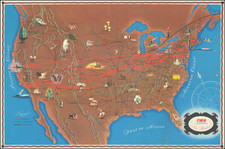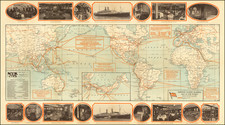Drink and be Merry - Van Geelkercken's Wine and Beer World Map.
This remarkable world map, elaborately engraved by Nicholas van Geelkercken and first published by Johannes Janssonius in 1617, stands as a testament to both the cartography and cultural priorities of the early 17th-century Netherlands.
The Cartography
The cartography in this map broadly follows Van Geelkercken's double-hemisphere world map of 1610 (Shirley 269). In the previous world map, Van Geelkercken included a large inland sea in North America, following information from John Smith via Henry Hudson and Jodocus Hondius; with this map, he has done away with that speculation. Southeast and Northeast Asia are somewhat revised.
South America has been revised to include the Le Maire Strait ("Lameers Straet"), at least in the present 1618 state. Van Geelkercken's map was published shortly after the culmination of Joris van Spilbergen's circumnavigation in 1617. Shirley complains that the map text erroneously states Spilbergen transited the Strait of Magellan in 1615; this is incorrect. Spilbergen did, in fact, transit the Strait between March 8 and May 1615.
Van Geelkercken is further associated with the Le Maire and Schouten voyage in publishing Oost ende West-Indische Spiegel in 1619.
A Decorative Triumph
Beyond the map's fascinating geographic eccentricities, it is bordered with unusual vignettes that offer a window into the life and times of the Dutch in the early 17th century. Notably, the imagery is imbued with a celebratory appreciation for wine and beer. To the lower left, scenes of winemaking culminate in a vintner savoring his creation. The lower right introduces us to a refined gentleman, comfortably seated by a fireplace indoors, sipping ale from a stein. Outside, the theme of revelry continues with a dancing duo, the man triumphantly raising a stein. These vivid depictions underscore the significance of wine and beer in Dutch culture, encapsulating the society's passion for celebration, quality, and the good life. Contrastingly, in the upper left, a maiden proudly holds a bouquet and garlands of flowers, set against a backdrop of scenes of spring, including three men trying to shoot a bird from atop a tall pole, apparently an early Dutch game. The upper right corner presents a figure cherishing fruits and grains, with a montage of harvest activities in the fields and orchards unfurling behind her. These scenes and personifications represent the seasons; the upper left is spring, the upper right is fall, the lower right is winter, and the lower left is summer.
Following Petrus Plancius's 1594 world map, Dutch world map publishing saw a flourishing of decorative border engraving. This style placed equal emphasis on the map's cartographic details and its ornamental elements. The trend continued into the first half of the 17th century and gave us a series of spectacular and often quite rare world maps.
This map features an elaborate scene of the Last Judgement below the two hemispheres and a depiction of Adam and Eve in the Garden of Eden above the hemispheres. In his previous world map, these scenes were inverted.
Shirley notes of the map:
The signatures on this vividly decorative map indicate the author as Nicolaes Geelkercken and the publisher as Jan Jansson. Geographically, the map is little different from Geelkercken's [1610 world map] . . apart from a redrawn north-east coast of Asia and the omisssion of the lake in North America. However, the rich external decoration is quite new. In the corners there are rural scenes illustrating the four seasons, and, in the upper and lower center parts, panoramas of the Garden of Eden and the last Judgement. Some of the human details, milkmaids, reapers, skaters -- are particularly lively.
States
Shirley (295) lists the following states:
- Dated 1617, "still shows only Magellan's strait."
- Dated 1618, "four or five examples are extant."
- Undated. Shirley is unclear about where this state fits in the chronology but implies it falls in between the second and fourth states.
- Dated 1632.
- Later states are implied by circumstantial evidence outlined in Shirley 295.
While J. Keunig (in Nicolaas Geelkerken, Imago Mundi XI, 1954, pages 174-177) concluded that the map was first published in 1616, no example is known to have survived with this date, and only two known examples of the 1617 edition have survived. Shirley concludes there is no support for Keunig's contention of a 1616 publication.
Shirley seems to indicate that Henricus Hondius had the copperplate substantially modified and reissued in the 1630s: "In 1639 the centre hemispheres were combined with new borders under Henricus Hondius' name to produce a two-sheet world map: see [Shirley] Entry 348." If this is what Shirley meant, he is incorrect. While the 1639 Hondius map closely follows Van Geelkercken's in its cartography, it is printed from a completely new copperplate.
Rarity
Shirley says that of the 1618 edition, only "four or five examples are extant." That number has increased slightly since he wrote, but it is still less than 10.
Jan Janssonius (also known as Johann or Jan Jansson or Janszoon) (1588-1664) was a renowned geographer and publisher of the seventeenth century, when the Dutch dominated map publishing in Europe. Born in Arnhem, Jan was first exposed to the trade via his father, who was also a bookseller and publisher. In 1612, Jan married the daughter of Jodocus Hondius, who was also a prominent mapmaker and seller. Jonssonius’ first maps date from 1616.
In the 1630s, Janssonius worked with his brother-in-law, Henricus Hondius. Their most successful venture was to reissue the Mercator-Hondius atlas. Jodocus Hondius had acquired the plates to the Mercator atlas, first published in 1595, and added 36 additional maps. After Hondius died in 1612, Henricus took over publication; Janssonius joined the venture in 1633. Eventually, the atlas was renamed the Atlas Novus and then the Atlas Major, by which time it had expanded to eleven volumes. Janssonius is also well known for his volume of English county maps, published in 1646.
Janssonius died in Amsterdam in 1664. His son-in-law, Johannes van Waesbergen, took over his business. Eventually, many of Janssonius’ plates were sold to Gerard Valck and Pieter Schenk, who added their names and continued to reissue the maps.
Nicholas (sometimes Nicolaes, Nicolaas, or Nicolas) van Geelkercken (sometimes Geelkerken, or Geilekerck) (fl. 1600-1656) a Dutch cartographer from the 17th century, isn’t as prominently recognized as some of his peers. However, his contributions to the field are noteworthy and deserve attention. There's some debate over his birthplace; Waller suggests Scherpenzeel in Guelders, Hollstein posits Zutphen, and some even point to Geilenkirchen in Germany due to the similarity in name.
The first known record of Geelkerken’s work dates back to 1600, with a depiction of the Castle of Verwolde. Then, a decade-long gap ensues until 1610, when records show his various roles as a draughtsman, engraver, publisher, and surveyor. Initially, he lived in Leiden, briefly in Amsterdam around 1615 and 1616, and later moved to Arnhem after his appointment as the surveyor of Guelders. He passed away on September 25, 1656, and was succeeded by his son Isaak.
In 1610, Geelkerken produced a map of the world titled Universi Orbis Tabula De integro Delineata. This map, printed in Amsterdam, measured 41 by 56 cm and featured allegorical images of the then-known parts of the world. Notably, it showcased the voyages of notable explorers such as Magelhaen, Candish, Drake, and Van Noort.
By 1616, Geelkerken released another world map published by Johannes Janssonius. Although the first edition of this map hasn't been found, later editions from 1618 are available. This map, too, had details about famous explorers, and notably lacked updates about the discoveries of Schouten and Lemaire.
In 1619, Geelkerken published Oost ende West-Indische Spiegel, which detailed the voyages of Joris van Spilbergen and Schouten and Lemaire. Within this work was a world map, which later influenced the works of other cartographers.
One of Geelkerken's projects was also engraving for a map of Pomerania by Eilhard Lubin, which spanned 12 sheets and was quite detailed. Similarly, Geelkerken was involved in creating a map of Palestine in collaboration with his brother Arnoldus Geilkerkius, who had traveled to Palestine.
Apart from these, Geelkerken made significant contributions to the mapping of Friesland. In Ubbo Emmius' De Frisia et Frisiorum Republica, Geelkerken presented detailed plans of the Frisian towns. Furthermore, his map of Frisia, created in 1618, provided a comprehensive view of the region during that time.
Geelkerken’s work also included a 1621 map of Rhaetia and his participation in Phil. Cluverius' Italia antiqua in 1624. His dedication to the field was evident in the numerous war-maps and historical prints he engraved, particularly those related to the Julierswar of the early 1610s.
In summary, while Nicolaas Geelkerken might not be the most celebrated cartographer, his dedication to his craft and the multitude of maps he contributed to reflect his essential role in the cartography of the 17th century.









![[Volcanos and the Subterranean World] Tabula Geographico-Hydrographica Motus Oceani, Currentes, Abyssos, Montes Igniuomos In Universo Orbe Indicans, Notat Haec Fig. Abyssos Montes Vulcanios](https://storage.googleapis.com/raremaps/img/small/95720.jpg)
![[ Ancient World ] Christianographie](https://storage.googleapis.com/raremaps/img/small/80305.jpg)



![Western Hemisphere [and:] Eastern Hemisphere](https://storage.googleapis.com/raremaps/img/small/102187.jpg)